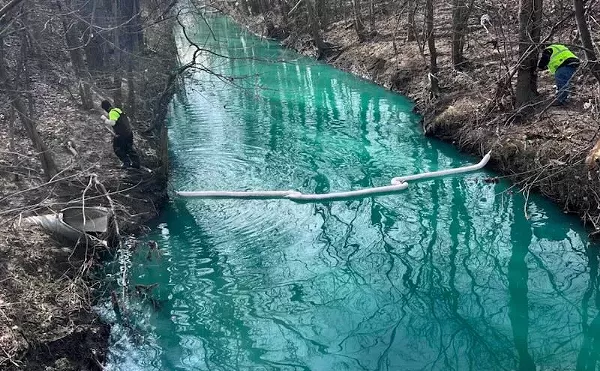
Audio By Carbonatix
[
{
"name": "GPT - Leaderboard - Inline - Content",
"component": "35519556",
"insertPoint": "5th",
"startingPoint": "3",
"requiredCountToDisplay": "3",
"maxInsertions": 100,
"adList": [
{
"adPreset": "LeaderboardInline"
}
]
}
]
Everett Stewart routinely picks up his son, Alexander, from school at the corner of Conner Street and Jefferson Avenue, walks with him the few blocks to Maheras Park, and watches while the 5-year-old throws rocks in the Detroit River and looks for fish. Freighters cruise by, wildflowers bloom, and the Stewarts are an urban planner's dream.
The father and son are doing exactly what many envision will happen throughout southeast Michigan as miles of existing and proposed "greenway" corridors are developed, linked, improved and maintained. They're exercising, enjoying the natural environment and learning about the area.
If visionary planners, community advocates and environmentalists have their way, a greenway with marked routes — mainly bike paths and widened sidewalks — eventually will meander through seven counties, offering natural landscapes, exercise areas and signs explaining historical and environmental aspects of the route.
In some places, establishing the greenway simply involves marking an existing widened sidewalk. In others, land and construction are required. Every project needs more money and competes with other worthy efforts for attention.
Regardless, when Stewart walks along the route near his home on Detroit's east side, he's on a tiny portion of what may eventually be a huge regional project.
"Five years ago, nobody was talking about this stuff," says Gregory Parrish, Detroit's manager of planning.
The park the Stewarts visit is part of the planned Conner Creek Greenway, which would follow the route of the former waterway from its terminus at the Detroit River back to its former upper reaches near Eight Mile Road. There it would link Macomb County's greenway with Detroit's.
"I think this is a good idea for this area," says Stewart, a diabetic who needs daily exercise. "I always walk around here and I like to take Alexander and burn some of his energy up because he's got a ton of it."
Throughout the city, Parrish has watched grassroots community groups work with large foundations that are funding the projects and municipal planners who are helping to design the routes. For the Conner project, that's largely the Nortown Community Development Corp., where leaders and volunteers have successfully applied for grants and raised matching money to improve parts of the roughly 9-mile route.
"What's actually getting into the ground a little bit now is really connecting along the streets," Parrish says.
2,400 miles of trail?
At an October meeting with seven counties and Detroit represented, planners and community advocates presented their individual community plans and integrated them as a regional project. The resulting maps show connections from Monroe County to Port Huron with routes into Livingston and Washtenaw counties as well as the tri-county area.
"We're got agreement from most of the counties and the city [of Detroit] that this is a plan we can all agree on," Parrish says. "In essence, there's a regional plan for greenways."
During the last several years, the Community Foundation for Southeast Michigan has provided 106 grants totaling $15.3 million to local communities for the project as part of its GreenWays Initiative, says President Mariam Noland. Those foundation grants allowed recipients to earn other state, federal and private funds totaling $89.5 million.
"Having access for recreation, environmentally helping re-green the region, is of interest to us, but one of the main reasons is that it helps build community and it also breaks down boundaries," Noland says. "It also helps governmental units work together and be more collaborative."
The project's scope could be huge. A Rails-to-Trails Conservancy study reported the potential for 2,400 miles of trails in southeast Michigan. "That's the big vision," says Anne Weekley, vice president of the community foundation. The GreenWays Initiative-funded projects will total about 100 miles — double the existing routes — when completed.
"It will obviously take years for the whole thing to come to fruition," Weekley says.
Among the foundation-funded projects under way:
• In Livingston County's Hamburg Township, $111,250 is supporting construction of a trail along an abandoned railroad corridor to connect a state park and South Lyon and Lyon Township trail systems.
• In Oakland County's Waterford Township, the foundation's predevelopment grant is funding design and engineering plans for a route along the Clinton River and through the civic center complex.
• In Detroit, foundation money has paid for a cost analysis to link Riverside and Clark parks with Historic Fort Wayne, construction of the downtown RiverWalk, and planning work for the Conner Creek route.
"For the city of Detroit, it's not about, I don't believe, creating wood chip trails. We can do that within parks but that's not really the emphasis we heard from the community. They want linkages," Parrish says.
Challenges ahead
Like all of the greenway subprojects, the Conner route has its challenges. Some of it needs major construction. For example, how would it cross I-94 where busy, congested, narrow roadway overpasses currently leave little room or comfort for cyclists, let alone a pedestrian walkway?
Would City Airport officials move a fence several feet to make room for a wider-than-normal sidewalk along the roadway? How would it best wind through the neighborhoods and industrial land in the several blocks inland from the river?
Still, while those questions remain unanswered, a few sections of the Conner route are done: Maheras Park is open; a paved trail follows one end of the City Airport property and stretches across Gratiot Avenue through a park; and the Nortown Community Development Corp. broke ground last year on the Milbank section near Eight Mile Road.
In a small, crowded office at the St. John NorthEast Campus, the Nortown CDC has paid staff of two — a director and an administrative assistant. The CDC has built and leased nearly 100 new, single-family homes in the area and distributes funds to local businesses for facade improvements.
Constantly raising money through grants, Nortown executive director Pat Bosch has big dreams. As she drives through the neighborhoods surrounding the Conner Creek route, she only sees potential projects to improve the community.
A native of the area, Bosch remembers being a child and playing on a footbridge over a pool of water that was the remnant of Conner Creek, which is now an underground drainage channel for the city. That spot is now the site of the quarter-mile Milbank stretch of the Conner Creek Greenway. It replaced an overgrown, unpaved former roadway and now connects Van Dyke Street with a small park.
"We'll try and beautify it with some foliage. We'll probably be working on it through July," Bosch says.
Much of the energy driving the Conner Creek project comes from the Nortown CDC, says Alan Levy, Detroit's deputy director for planning and development.
"I think that's kind of how Milbank happened. It's really been pushed by Nortown. It was something they decided was a high priority for them, and they made it happen," he says. "Eventually it will be substantially completed and then completely done."
As will be the entire Conner Creek Greenway someday, Bosch says.
"Every challenge is laying a foundation for the next job we're doing and the next job we're doing," she says.
Still, the work has not gone unappreciated by residents of the area. Nursing student Linda Dixon says she noticed the new park benches, bricked walkway and improved landscape at the corner of Conner and Gratiot Avenue. She looks forward to more of the Greenway route being completed.
"A lot of people like to ride bikes around here," she says. "I would use it a lot."
Sandra Svoboda is a Metro Times staff writer. Contact her at 313-202-8015 or ssvoboda@metrotimes.com




